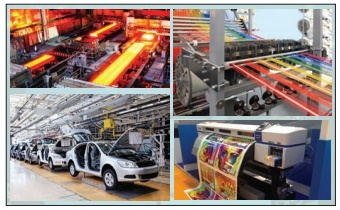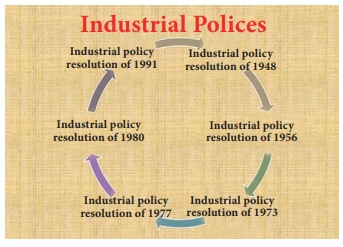Chapter: 12th Political Science : Chapter 8 : Planning and Development Politics
Industrialization
Industrialization
Industrialization has been one of the most
significant processes in the Indian economic development since independence.
After independence, the leaders understood the importance of industrialization
for our country.
They initiated the process of industrialization
under the Industrial Policy Resolution 1956 and in all the five year plans
industrialization was given due importance. The initiatives of the governments
led to a considerable increase in industrial production making India the sixth
most industrial country in the world. The development in industries spread
across both small scale and large scale and included consumers, intermediate
and capital goods.

Due to the progress in industrialization a change
in foreign trade of India could be seen. India increased the export of
engineering goods. Correspondingly, there was development of technological and
managerial skills as the industries had to be operated and also planning and
designing of the industries had to be done in an efficient manner. Heavy
industries were developed and high technical capability also had to be
developed in terms of improved infrastructure, advanced technology and
appropriate production equipments. The engineering industry was the key to the
industrial development of India. It had to be developed as per the strategy of
the planners to accelerate industrialisation in India.
During the planning process, there was development
of basic and capital these industries increased from 50 percent in 1959 to 79
percent in 1990-91. This showed an increase in employment. The number of
workers in factories and mines increased tremendously. Industrialization
improved the iron and steel, fertilizers, chemicals, cement and non-ferrous
metals industries. New capital goods industries were started and developed.
During this period, there was a huge expansion of
infrastructural facilities in the country. The petrochemical industries
developed with efficient refineries, pipelines, storage and distribution
systems. These were drastic changes in the economy with improved irrigation
system, storage works and canals, hydro and thermal power generation, improved
railway system and well laid national and state highways. Better transportation
and developed telecommunication system were instrumental in connecting India to
the rest of the world.
With the introduction of economic reforms in India,
there were changes in the industrial pattern of India. There was faster growth
of capital goods and consumer goods and there was a slowdown in the rate of
growth of basic industries. The growth in banking, insurance and commerce and also
the expansion and modernization of ports, shipping and both domestic and
international air services have all been due to these economic changes which
led to enlargement in industries.
Tremendous changes happened in the field of science
and technology as well. The contribution of Indian scientists to different
fields including agriculture, industry, technology, communication etc. have
been tremendous. Many people were trained in the technical field which included
cement factories, chemical fertiliser units, oil refineries, power houses,
steel plants, locomotive factories,engineering industries etc.
Industrial policy
An effective industrial policy is essential for any
industrialised nation. It enables the state to have proper policies, rules and
regulations so that the industries can be regulated and the process of
industrialization benefits the economy and the society.

Industrial Policy Resolution 1948
As the Indian system incorporated the concept of a
mixed economy, the Industrial Policy Resolution adopted in 1948 emphasised that
both the public sector and private sectors would function in their respective
spheres. All the key industries were to be under the control of the central
government. The public sector had control over arms and ammunitions, the
production and control of atomic energy, railways etc. which were to be the
exclusive monopoly of the central government. The state also had control over
coal, iron and steel, aircraft manufacturing, ship building etc.. Private
enterprises and the cooperatives managed the remaining industries.
Industrial Policy Resolution 1956
A new industrial policy was formulated and was
adopted in April 1956. As per this policy, three categories of industries were
specified. There were industries which were totally controlled by the state,
industries which were owned by the state and the private enterprises which
could supplement in the management of such industries and the third category of
industries were those which were exclusively managed by the private
enterprises. The industries of the private sector were to be encouraged by the
state by improved systems of transport, power sector and other services. The
small scale industries and cottage industries were also to be encouraged by the
state.
Industrial Policy, 1980
An industrial policy was announced by the congress
government in July 1980. It stressed on a pragmatic approach towards
development acknowledging the Industrial Policy Resolution of 1956. It
emphasised on an integrated industrial development with setting up of nucleus
plants in industrially backward regions. Small scale units and cottage
industries were to be started which could function more effectively using
improved technology. It aimed at promoting a concept of economic federalism.
The industrial policy of 1980 made considerable
changes by bringing about a liberalised licensing policy by which the large
undertakings were much benefitted as they were made free from the MRTP Act and
FERA. The government delicensed industries which were located in the areas that
were declared as backward. The concept of broad banding was introduced. This
gave flexibility to the manufacturers in production as the products could be
designed as per the demands of the market.
Industrial Policy 1991
A new industrial policy was introduced by the
P.V.Narasimha Rao government in July 1991. This was a landmark in the economic
history of the nation because the government had introduced its policy of
liberalization.
New Economic Policy was introduced in
India on July 24, 1991 under Prime Ministership of P.V. Narasimha Rao, Dr.
Manmohan Singh the Finance Minister is regarded as the Father of New Economic
Policy of India.
The Act from centralized bureaucratic control. The
conditions of public enterprises was reexamined as they showed very less rate
of growth. So, entrepreneurs were freed from restriction of MRTP Act and
restrictions on direct foreign investment was removed. The Indian economy was
integrated with the world economy through this policy of liberalization. Major
reforms were introduced in the areas of industrial licensing, foreign
investment, foreign technology, public sector policy and MRTP Act.
Changes were made with regard to industrial
licencing which was abolished for many industries. As per the new Act,18
industries were included for compulsory licensing. Some of the industries in
this category were coal and lignite, petroleum, sugar, industrial explosives,
hazardous chemicals, electronic aerospace and defence material, drugs and
pharmaceuticals etc..It comprised of industries which were related to security
concerns, health, environment etc. In 1993, three more industries were removed
from the list of 18 industries under the compulsory licensing. They were motor
cars, white goods (which include refrigerators, washing machines, air
conditioners etc.) and raw hides and skins and patent leather.
Rehabilitation schemes were introduced with the
help of the Board for Industrial and Financial Reconstruction (BIFR) so that
the public enterprises whose performance was poor could be improved. During
such a rehabilitation process, the interest of the workers of such industries
was to be protected.
Competition Act, 2002
The Monopolies and Restrictive Trade Practices Act
(MRTP),1969 was repealed by the Ministry of Corporate Affairs and this was
replaced by the Competition Act,2002 which was later amended in 2007 and 2009.
The MRTP Act had the objective of preventing the concentration of money and
checking unfair practices in trade so that monopolistic practices could be
stopped. But, the new Act encouraged freedom of trade so that there was healthy
competition and the consumer could get the best products. Emphasis was given to
regulating the activities of the companies. The companies did not have to get
the prior approval of the government in making changes in their establishments.
In spite of many efforts towards industrialization,
there are also few inadequacies. India still has the problem of unemployment
and underemployment. Uniform development in all regions is a challenge to the
policy makers and the larger society. Even after long years of independence and
industrialization, governments have to still design programmes for poverty eradication.
The industrialization process leads to the development of large sectors but the
small and medium sectors still have a long way to go. More and more industries
are concentrated in cities. In terms of development there is a vast difference
between the urban areas and the rural areas. Issues relating to urbanization
and migration are bigger challenges to the state.
Activity:
Make a presentation
on large scale industries in India.
Related Topics